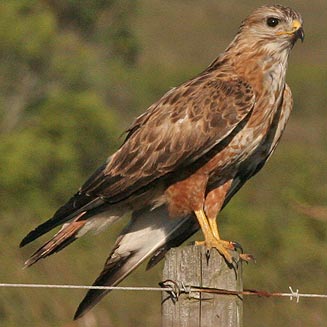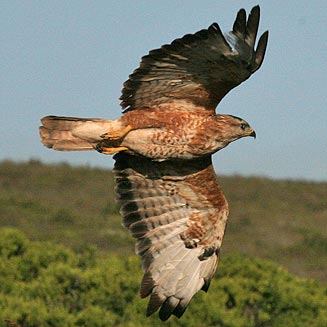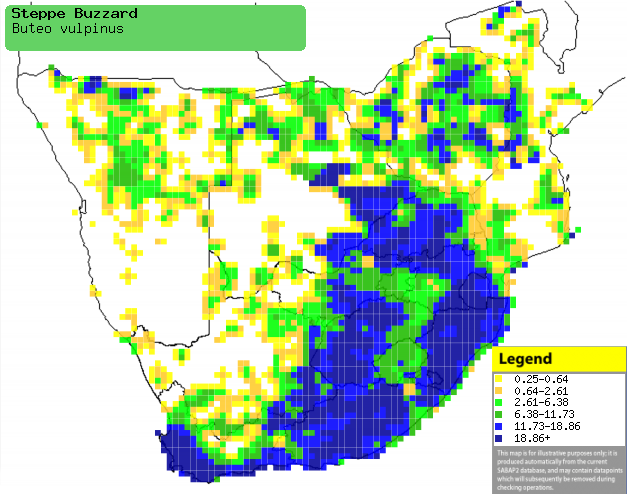|
Buteo vulpinus (Steppe
buzzard)
[= Buteo buteo]
Bruinjakkalsvoël [Afrikaans]; Isangxa [Xhosa]; Siimbi
[Kwangali]; Khajoane (also applied to Jackal buzzard) [South Sotho];
Phakwê (generic term for some of the smaller raptors), Segôdi [Tswana];
Buizerd [Dutch]; Buse des steppes [French]; Mäusebussard [German];
Bútio-comum [Portuguese]
Life
> Eukaryotes >
Opisthokonta
> Metazoa (animals) >
Bilateria >
Deuterostomia > Chordata >
Craniata > Vertebrata (vertebrates) > Gnathostomata (jawed
vertebrates) > Teleostomi (teleost fish) > Osteichthyes (bony fish) > Class:
Sarcopterygii (lobe-finned
fish) > Stegocephalia (terrestrial
vertebrates) > Tetrapoda
(four-legged vertebrates) > Reptiliomorpha > Amniota >
Reptilia (reptiles) >
Romeriida > Diapsida > Archosauromorpha > Archosauria >
Dinosauria
(dinosaurs) > Saurischia > Theropoda (bipedal predatory dinosaurs) >
Coelurosauria > Maniraptora > Aves
(birds) > Order: Falconiformes
> Family: Accipitridae
> Genus: Buteo
 |
 |
|
Steppe buzzard, between West Coast Fossil Park and
Cape Town, Western Cape, South Africa. [photo H. Robertson, Iziko
©] |
Steppe buzzard, between West Coast Fossil Park
and Cape Town, Western Cape, South Africa. [photo H. Robertson, Iziko
©] |
Distribution and habitat
Breeds from eastern Europe to Siberia, heading south in the
non-breeding season to southern Europe and sub-Saharan Africa. It occurs in all
countries of southern Africa, but it is especially common in South Africa,
Swaziland, Botswana and Zimbabwe. It generally favours open habitats, such as savanna,
grassland and open woodland, often moving into mosaics of croplands.
|
 |
|
Distribution of Steppe buzzard in southern Africa,
based on statistical smoothing of the records from first SA Bird Atlas
Project (©
Animal Demography unit, University of
Cape Town; smoothing by Birgit Erni and Francesca Little). Colours range
from dark blue (most common) through to yellow (least common).
See here for the latest distribution
from the SABAP2. |
Movements and migrations
Palearctic breeding migrant, leaving its
breeding grounds in September and early October then heading south to
southern Africa, arriving in the period from late
October-November. It eventually departs from the region in late
February and March.
Food
Its diet in southern Africa is not well-known, but it is
thought to consist mainly of insects and small mammals. It does most of its
foraging from a prominent perch, such as a tree or telephone pole, dropping onto
the ground once it spots prey. The following food items have been recorded
in its diet in southern Africa:
- Vertebrates
- Invertebrates
Threats
Not threatened.
References
-
Hockey PAR, Dean WRJ and Ryan PG 2005. Roberts
- Birds of southern Africa, VIIth ed. The Trustees of the John Voelcker
Bird Book Fund, Cape Town.
|
